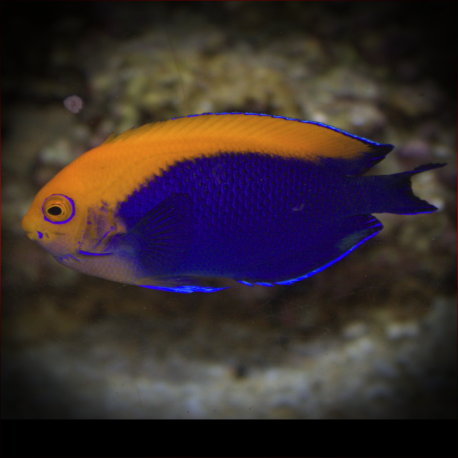More info
Datasheet
| Minimum Tank Size | 200 litres / 52.83 US gallons |
| Maximum Size | 7.0cm / 2.76inches |
| Reef Compatible | Often reef safe |
| Temperament | Aggressive towards other species |
| Temperature | 22.2°C / 71.96°F - 25.6°C / 78.08°F |
| Specific Gravity | 1.020-1.025 |
| Carbonate Hardness | 8-12 |
| pH | 8.1-8.4 |
General Description
The Flameback Angelfish, scientifically known as Centropyge aurantonotus, belongs to the Pomacanthidae family. These fish are renowned for their vibrant colors and are considered some of the most eye-catching species on the reef. They are relatively small in size, typically growing up to about 10 cm, with some specimens reaching up to 18 cm. Flameback Angelfish are popular in aquariums due to their manageable size compared to other Angelfish species.
Aquarium Suitability
Flameback Angelfish are categorized as suitable for aquariums but with caution. They can exhibit aggressive behavior towards other fish, especially those that are more docile. When kept in an aquarium, it is essential to provide regular feeding, ample hiding spots, and sufficient space to help mitigate their aggressive tendencies.
Demands, Care, and Hardiness
These Angelfish have average hardiness levels and require a well-established aquarium with plenty of algae for grazing. They thrive on a diet of microalgae and detritus, with supplementary feedings of foods like spirulina and fresh vegetables. Maintaining high water quality is crucial to prevent stress-related issues.
Reef Suitability
Flameback Angelfish are often considered reef-safe, but there is a risk they may nip at certain corals, such as LPS and Zoanthids. Careful consideration must be taken when selecting tank mates and coral species to ensure compatibility.
Aquarium Setup
For optimal care, the aquarium housing Flameback Angelfish should have ample hiding places, especially when introducing new fish. It is advisable to provide a mix of coral species that are less likely to be targeted by the Angelfish, such as Hammer corals, Bubble corals, Star polyps, and Disc anemones. Proper space allocation based on the size of the fish is crucial for their well-being.
Behaviour
Flameback Angelfish may exhibit territorial and aggressive behavior, particularly towards other fish species. Providing hiding spots and creating a well-structured environment can help manage their behavior in the aquarium.
Feeding and Diet
These Angelfish primarily feed on microalgae but can also consume small crustaceans like krill, mysis, and artemia. Offering a varied diet that includes spirulina, nori, and fresh vegetables is beneficial for their nutritional needs.
Dimorphism and Captive Reproduction
Flameback Angelfish have the ability to change gender from female to male as needed. Captive reproduction of these fish can be challenging and requires specific conditions to mimic their natural habitat.
Habitat and Distribution
Native to the Western Atlantic from the southern Caribbean Islands to São Paulo, Brazil, Flameback Angelfish inhabit rocky reefs and areas abundant in algae for grazing. Understanding their natural habitat can aid in creating a suitable environment in captivity for their overall well-being.

